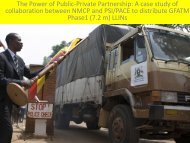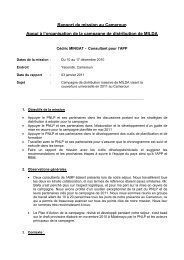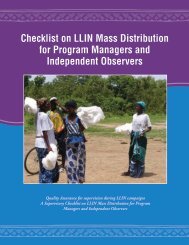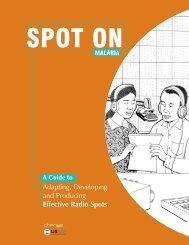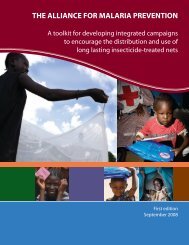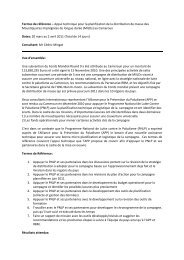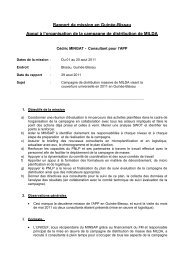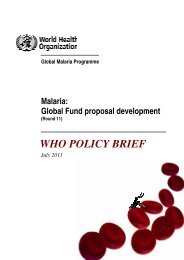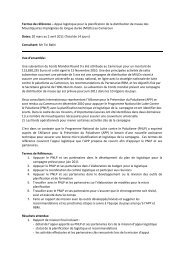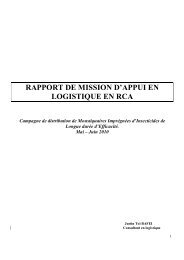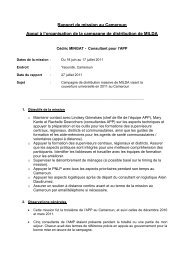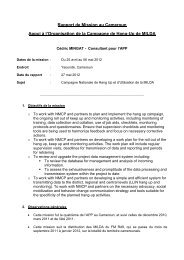Anambra State Post-Campaign Net Tracking Survey
Anambra State Post-Campaign Net Tracking Survey
Anambra State Post-Campaign Net Tracking Survey
You also want an ePaper? Increase the reach of your titles
YUMPU automatically turns print PDFs into web optimized ePapers that Google loves.
Discussion<br />
<strong>Survey</strong> methodology and data validity<br />
<strong>Anambra</strong> LLIN campaign evaluation<br />
The intention of this data collection was to obtain information from households on the process<br />
and outcome of the <strong>Anambra</strong> LLIN campaign that would be statistically representative of the<br />
population of <strong>Anambra</strong> <strong>State</strong>. In order to achieve such representativeness, the sampling<br />
methodology was critical. In this survey, the classical two stage cluster sampling was applied as<br />
it is also used in standard national surveys such as MICS and DHS. The only difference was that<br />
instead of complete list of all census enumeration areas, a list of wards with the aggregated<br />
households registered for the campaign was used to allocate clusters to locations proportionate<br />
to population density and then a list of all villages (settlements) was obtained from the local<br />
authorities in order to select one at random. With respect to the statistical representativeness,<br />
this process is equivalent to the DHS procedure. At cluster level, the survey also followed<br />
standard DHS/MICS protocol by compiling a complete list of eligible households at the day of the<br />
survey from which the interviewed households were selected using random number lists. By<br />
applying sampling weights proportionate to the selection probabilities of clusters and<br />
households based on the actual response rate in the data analysis, the survey methodology used<br />
all the “state of the art” approaches and can be considered a truly representative sample.<br />
The survey consciously did not use any data or listing from the LLIN campaign for selection of<br />
respondents in order to ensure that any village or household that did not participate in the<br />
campaign but was eligible at the time would be included in the sampling frame. The only caveat<br />
of this procedure is that a family that had only moved to the location after the campaign would<br />
also be included in the survey. However, if this family moved within <strong>Anambra</strong> <strong>State</strong>, they would<br />
have been equally eligible to participate in the campaign and the proportion of out-of-state<br />
immigration in a predominantly rural population is very unlikely to be of a magnitude that would<br />
have distorted the results.<br />
Like any survey that relies on interviews with household respondents, this survey was prone to<br />
potential recall and misclassification biases. Age heaping and misclassification were likely to be<br />
present to a certain degree in a number of responses. Nonetheless, many aspects of<br />
demography such as proportion of children under five, currently pregnant women and socioeconomic<br />
characteristics regarding education and household assets were found to be as one<br />
would expect from other data sources suggesting a high level of consistency. Furthermore,<br />
results were consistent in many ways within the dataset regarding trends with age and/or<br />
wealth quintiles as well as previously known net ownership so that in total the results can be<br />
considered as valid within the limits of the described range of precision.<br />
LLIN distribution and universal coverage<br />
The declared objective of malaria prevention with ITN/LLIN in Nigeria is universal coverage, i.e.<br />
access to nets by all population groups with the target of reaching at least 80% of households<br />
with two or more ITN. This target was almost reached through the LLIN distribution campaign in<br />
<strong>Anambra</strong>: 74.4% received any LLIN through the campaign and 68.2% at least two and statistically<br />
2.15 nets were delivered on average to each of those who received any resulting in an overall<br />
household ownership with any LLIN at the time of the survey of 64.3% and 57.3% owning two or<br />
more LLIN. While this is short of the target, this is also a tremendous improvement from the precampaign<br />
situation where ITN ownership was estimated to be only 2.0%.<br />
45


